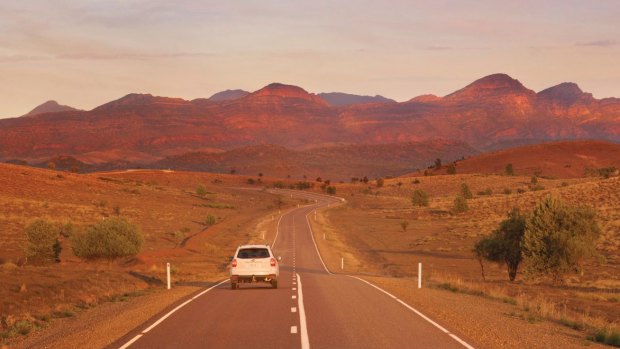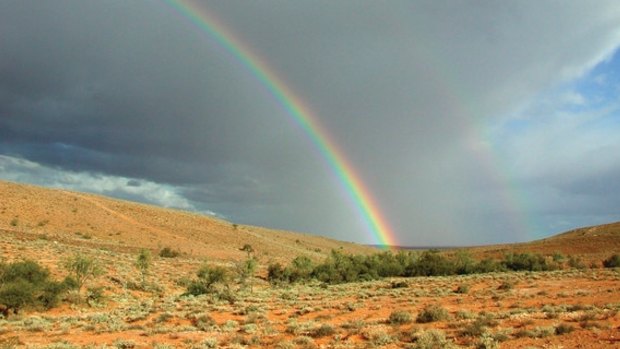This was published 5 years ago
Nilpena Station, Flinders Ranges: home to a 550-million-year-old fossil site

Flinders Ranges Way, Wilpena Pound.Credit: Adam Bruzzone
Professor Jim Gehling is down on his knees, the outback winds whipping around him, telling us the fossils embedded in the rocks beneath our feet are our ancestors. My four travel companions and I peer down at the golf ball-sized creatures, bizarre centipede-scorpion looking things with legs splaying out in a halo around their bodies, then at each other. The resemblance is far from uncanny.
We're at Nilpena Station, a 150-year-old sheep station west of South Australia's Flinders Ranges, that's also home to a 550-million-year-old fossil site. Gehling is our guide for the afternoon - the 70-year-old paleontologist is one of the world's leading researchers of the ediacara biota, the oldest known complex animal fossils on Earth, that are twice as old as dinosaurs. He has dedicated most of his working life to these extraordinary critters and knows so much about them that Sir David Attenborough travelled here to film with him twice, first in 2009 as part of his First Life documentary, then again in 2013. So while these fossils may just look like embossed rocks to us, Gehling is helping us understand what a huge deal they are.
Half a billion years ago, says Gehling, most of the Flinders Ranges was beneath the ocean. These imprints, then, were once soft-bodied marine creatures, potentially the ancestors of worms and crustaceans, that would creep and crawl along the seafloor to feed.

The ediacara fossil site in South Australia.Credit: J. Gehling and associates
"Before there were animals, these things lived everywhere," says Gehling, his piercing blue eyes catching ours. "When they were first discovered here in 1946, by geologist Reginald Sprigg, it was the first time the remains of these sorts of creatures had been found in such abundance anywhere in the world."
As we try to wrap our brains around this information, we wander around the 100-year-old woolshed and homestead on the property, where we're told the film Rabbit Proof Fence was shot. Soon, we're ushered into a vehicle that looks more like a spaceship than a truck and, 10 minutes later, it deposits us in the midst of vast red sand dunes that complete the Mars expedition atmosphere. Within moments Gehling is on his knees again, this time pulling ancient Aboriginal grindstones and pirri points (stone tools) from the sand.
"You can find all sorts of things in these dunes," he says. "It's a lost world, and no one has any idea it's here." And that, really, is what's so striking about this corner of Australia. In the rust-coloured sands and rocks of the Flinders Ranges and outback, visitors can discover history dating back to the very beginning of life on our planet – yet there are no fences, no guards, no museums protecting any of it. The thought is as extraordinary as it is terrifying, particularly in this eBay era.
When we reach the next fossil site, an excavated sandstone bed a short drive away in the Ediacara Hills, we're handed some beige-coloured putty so we can create our own casts. Now it's our turn to be brought to our knees, scouring the smooth rock for imprints and pressing our putty into them. Studying the results, Gehling points out a head, a tail, and symmetrical halves with legs – the basic body plan, he says, of almost all animals alive on earth today. The thought that these creatures could therefore be our very, very distant cousins bends my mind as we're driven back to our hotel, beneath a light rain and a sky painted with a double rainbow.
By the time we arrive back at the Prairie Hotel, in the outback town of Parachilna, the rain has cleared. As the dropping sun sets the world aglow, we gather around one of the wine barrels set out the front of the charming sandstone building and order one of the Prairie's home-brew, Fargher Lager beers. Soon, we'll be tucking into the Prairie's famous "feral food" menu, filling our bellies with emu, kangaroo, quandong and more. Right now, though, we're content to simply sit and soak up the profound sense of infinity that can be felt out here. Looking down the empty main road, which seems to go nowhere, my mind drifts back to our tiny ancient ancestors. I suddenly feel very insignificant, in the best possible way.
Nina Karnikowski travelled as a guest of Flinders Ranges Odysseys and the South Australia Tourism Commission.
TRIP NOTES
MORE
FLY
Qantas flies several times daily from Sydney and Melbourne to Adelaide, from about $300 return. See qantas.com.au
TOUR
Flinders Ranges Odysseys offers a four-day Flinders Ranges Outback Tour from $3184 a person, with all accommodation (including one night at the Prairie Hotel), meals, tours, driver and entrance fees. Includes the Nilpena Station Ediacaran Experience Tour. flindersrangesodysseys.com.au
Sign up for the Traveller Deals newsletter
Get exclusive travel deals delivered straight to your inbox. Sign up now.